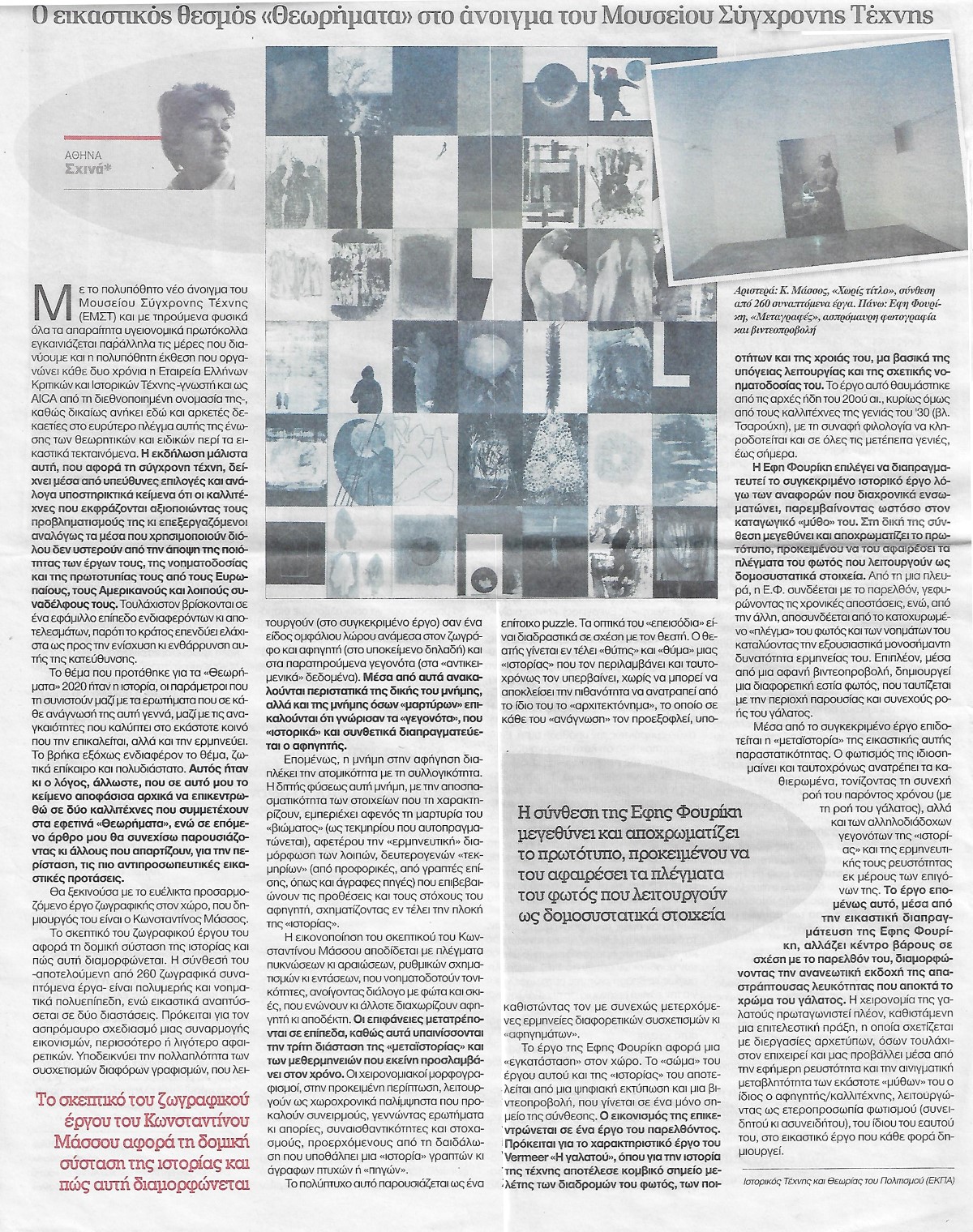Το έργο της αφορά μια «εγκατάσταση» στον χώρο. Το «σώμα» του έργου αποτελείται από μια ψηφιακή εκτύπωση και μια βινεοπροβολή που εστιάζεται σε ένα μόνο σημείο της σύνθεσης. Την βάση της διαλεκτικής και του προβληματισμού της Φουρίκη αφορά το ζωγραφικό έργο «Η γαλατού»(1657-8) του Jan Vermeer (1632-75) όπου για την ιστορία της τέχνης αποτέλεσε σημείο αναφοράς ως προς την αλληγορία του θέματος, μα βασικά για την υπόγεια λειτουργία του φωτός, που ακολουθεί μια διαγώνια κατωφερή πορεία, απαυγάζοντας τα επίγεια. Η Φουρίκη επιλέγει το συγκεκριμένο έργο, αφενός για την πολλαπλότητα των αναφορών που διαχρονικά ενσωματώνει, αφετέρου για το είδος ενός καταγωγικού «μύθου» που έχει διαμορφωθεί, στην διαδρομή της «ιστορίας» του. Στη δική της σύνθεση, μεγεθύνει το πρωτότυπο και φωτογραφικά το αναπαράγει, αποχρωματίζοντάς το ωστόσο, προκειμένου να του αλλάξει προσανατολισμό, για μια νέα και διαφορετική ερμηνεία του φωτός, που εκείνη φέρνει στο προσκήνιο. Η δημιουργός συνδέεται με το παρελθόν, αλλά και το παρόν. Γεφυρώνει χρονικές αποστάσεις, ανοίγοντας παράλληλα νέες οπτικές προσπελάσεις, μέσα από την βιντεοπροβολή της. Η δική της εστία φωτός κι ερμηνευτικών προσεγγίσεων, ταυτίζεται με την έννοια του εφήμερου, του διαρκώς μεταβαλλόμενου, του ζωτικά ασταθούς κι οργανικά επαναλαμβανόμενου γεγονότος της συνεχούς ροής του γάλατος. Το «παρόν» εμφανίζεται ως προγεφύρωμα της ρευστότητας της ύλης και ως «άκτιστη» παράλληλα λευκότητα ενός απαστράπτοντος φωτός. Παριστάνεται, με άλλα λόγια, ως υπαρκτή αλλά άπιαστη στιγμή, ανάμεσα στο παρελθόν και στο μέλλον.
Το παρόν της ροής (και της «πηγής» αιτίου κι αιτιατού, γεγονότος κι «ιστορικής» αφήγησης), ιδιοσημαίνεται ως ουτοπία, που εμπεριέχει ωστόσο την έννοια της «αρχετυπικότητας». Υποδηλώνεται το άχρονο στοιχείο της «πρωτογένειας» του γάλατος, καθώς παράλληλα φωτίζεται η συνεχόμενη «πράξη» της δημιουργικής επανάληψης, στο διηνεκές. Πρόκειται ουσιαστικά για μια τελετουργική πράξη, που ισοδυναμεί με την αφηγηματικότητα της «ιστορίας», καθώς αυτή πραγματοποιείται (μέσα από την επαναληπτικότητα της ροής του υγρού στοιχείου) στον τελετουργικό χρόνο, τον οριζόμενο ως «νυν και αεί».
Στο έργο αυτό, τονίζεται ο συγχρονιζόμενος και διαρκώς μεταβαλλόμενος προσδιορισμός της «ιστορίας». Το φως της δεν έρχεται «έξωθεν» και «άνωθεν», από το παράθυρο δηλαδή, όπως στο έργο του Vermeer, αλλά προκαλείται «ενδογενώς», από την ίδια την «πράξη» εκάστου γεγονότος και από την ποικιλία των αναγνώσεών του.
Ιστορικός Τέχνης & Θεωρίας του Πολιτισμού (ΕΚΠΑ)
Δελτίο τύπου απο EMST.GR ΕΔΩ

The work of Efi Fouriki involves an 'installation' in space. The 'body' of the work consists of a digital print-out and a video projection which focuses on a single point in the composition. The basis of the dialectic and problématique of Fouriki concerns the painting entitled 'The Milkmaid' (1657-8) by Jan Vermeer (1632-75), which for the history of art was a point of reference as to the allegory of the subject, but also, basically, for the subterranean function of the light, which follows a diagonal downward course, illuminating the earthly objects.
Fouriki has chosen this specific work, on the one hand, for the multiplicity of references which through time it has incorporated, and, on the other, for the genre of an origin 'myth' which has taken shape in the course of its 'history'. In her composition, she enlarges the original and reproduces it by photography, but draining it of colour in order to alter its orientation for the purposes of a new and different interpretation of the light which she brings to the forefront.
The artist is linked with the past, but also with the present. She bridges distances in time, at the same time opening up new visual approaches through her video projection. Her focus of light and interpretative approaches is to be identified with the concept of the ephemeral, of the constantly changing, of the vitally unstable and organically repeated event of the constant flow of the milk. The 'present' makes its appearance as a bridgehead of the fluidity of matter and, in parallel, as an 'uncreated' whiteness of a coruscating light. It is represented, in other words, as an existent but intangible moment, between the past and the future.
The present of the flow (and of the 'source' of cause and effect, of an event and of the 'historical' narration) lends itself meaning as a utopia which, nevertheless, also includes the concept of 'archetypicality'. What is alluded to is the 'primogeniture' of milk, as, at the same time, the continuing 'praxis' of creative repetition, in perpetuity, is illuminated. It is, in essence, a ritual act which is tantamount to the narrative nature of the 'story' as that is realised (through the repetitiveness of the flow of the liquid element) in ritual time, defined as 'now and always'.
In this work, the synchronised and constantly changing definition of 'history' is highlighted. Its light does not come 'from without' and 'from above' - from the window - as in Vermeer's work, but is 'endogenously' caused, by the same 'action' of each event and by the variety of its readings.
Press Release from EMST.GR HERE


